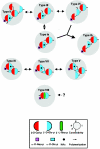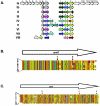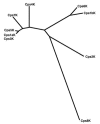Structural and genetic diversity of group B streptococcus capsular polysaccharides
- PMID: 15845517
- PMCID: PMC1087335
- DOI: 10.1128/IAI.73.5.3096-3103.2005
Structural and genetic diversity of group B streptococcus capsular polysaccharides
Abstract
Group B Streptococcus (GBS) is an important pathogen of neonates, pregnant women, and immunocompromised individuals. GBS isolates associated with human infection produce one of nine antigenically distinct capsular polysaccharides which are thought to play a key role in virulence. A comparison of GBS polysaccharide structures of all nine known GBS serotypes together with the predicted amino acid sequences of the proteins that direct their synthesis suggests that the evolution of serotype-specific capsular polysaccharides has proceeded through en bloc replacement of individual glycosyltransferase genes with DNA sequences that encode enzymes with new linkage specificities. We found striking heterogeneity in amino acid sequences of synthetic enzymes with very similar functions, an observation that supports horizontal gene transfer rather than stepwise mutagenesis as a mechanism for capsule variation. Eight of the nine serotypes appear to be closely related both structurally and genetically, whereas serotype VIII is more distantly related. This similarity in polysaccharide structure strongly suggests that the evolutionary pressure toward antigenic variation exerted by acquired immunity is counterbalanced by a survival advantage conferred by conserved structural motifs of the GBS polysaccharides.
Figures






References
-
- Chaffin, D. O., K. McKinnon, and C. E. Rubens. 2002. CpsK of Streptococcus agalactiae exhibits alpha2,3-sialyltransferase activity in Haemophilus ducreyi. Mol. Microbiol. 45:109-122. - PubMed
-
- Cieslewicz, M. J., D. L. Kasper, Y. Wang, and M. R. Wessels. 2001. Functional analysis in type Ia group B Streptococcus of a cluster of genes involved in extracellular polysaccharide production by diverse species of streptococci. J. Biol. Chem. 276:139-146. - PubMed
-
- Di Fabio, J. L., F. Michon, J.-R. Brisson, and H. J. Jennings. 1989. Structure of the capsular polysaccharide antigen of type IV group B Streptococcus. Can. J. Chem. 67:877-882.
Publication types
MeSH terms
Substances
Associated data
- Actions
- Actions
- Actions
- Actions
- Actions
- Actions
- Actions
Grants and funding
LinkOut - more resources
Full Text Sources
Other Literature Sources
Research Materials

